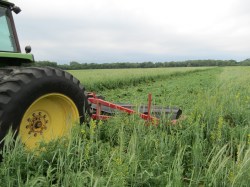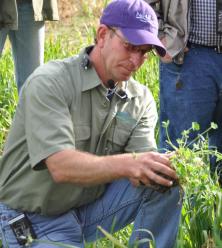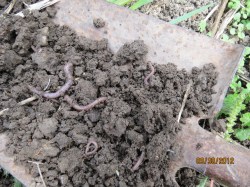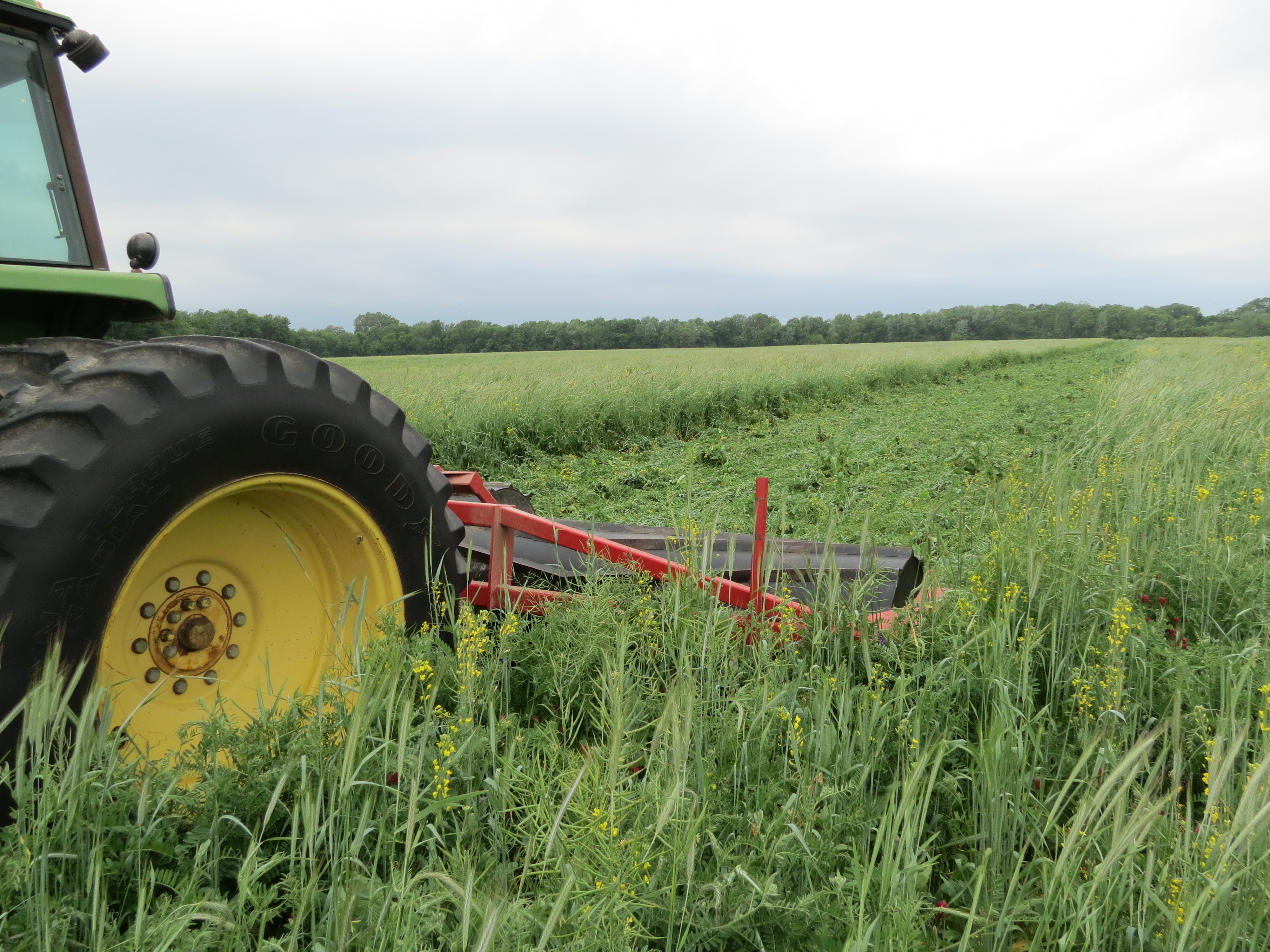
Gail FullerKeeping your soil covered with cover crops between food crops is a key ingredient to healthy soil.
In the 1990s, Gail Fuller stopped tilling his Kansas farm. He and his brother had inherited the farm and he wanted to move away from the way they’d been doing things in the 1970s and ’80s.
“I thought that once you got to no-till that was the answer. But I didn’t change my management practices, so no-till actually failed,” he recalls. “We were doing miserably by the early 2000s.”
Farmers like Fuller use the term “soil management” a lot, and the truth is it means different things on different farms. But when he compares the way he’s farming today to what he was doing 10 years ago, it’s not hard to understand what he means.
“We didn’t rotate our crops, we didn’t have enough crop residue in the soil, our erosion was high, our yields weren’t increasing, and our herbicide was up. We were on the verge of bankruptcy.”
That part about herbicide is important. You see, most conventional corn and soy farmers till — or break up — their soil on a large scale because it helps control the weeds. So it has become common to use more weed killer when you stop tilling. (The practice has been dubbed “chemical no-till” and it’s part of what has made the recent conversation about farm soil controversial.)
Fuller started planting cover crops — crops that, like their name implies, provide a cover to stop the soil from eroding between food crops, and provide a natural source of nutrients as well — and he radically upped the number of grains he grew. In addition to corn and soy, the farmer now grows both winter and spring wheat, winter barley, winter triticale, canola, sunflower, safflower, flax, oats, and peas, to name a few.
“We try to have something growing 24-seven, 365 days a year. I want a living root in the ground at all times.”

Gail Fuller and his soil.
In the larger sense, Fuller became a student of his own soil. And to hear him talk about it is oddly inspiring — even for a city girl who feels lucky if the tomatoes in her backyard don’t die prematurely.
When he first started this process, Fuller says his soil contained only around 1.5 to 2 percent organic matter (the living part of the soil, made up largely of decayed plant material). Now it ranges from 3.5 to 6 percent. “The native grasslands in this part of the country apparently had 6 to 7 percent, but I believe we can go higher than that,” he says.
Why does organic matter in soil, um, matter so much? For one, it makes the soil look different; it’s usually darker, spongier, and full of earthworms. Healthy soil also tends to make crops less vulnerable to pests. And, perhaps most importantly, soil with a lot of organic matter holds a more moisture. This helps farms remain more resilient through both droughts and floods — a huge variable, because while summer may be long gone, in many states, drought is stubbornly staying put.
Many farmers — especially the big corn and soy or “commodity” producers — will receive a controversial form of government-subsidized crop insurance to cover their losses. As Tom Laskawy wrote earlier this summer, it’s a broken cycle wherein most conventional farmers continue to strip the soil of nutrients, making their crops especially vulnerable to extreme weather, and yet we continue to pay them to farm that way through subsidies and insurance payments. According to Laskawy:
In commodity crop states like Iowa, upwards of 90 percent of the corn and soy crops are covered by insurance — with an additional federal agricultural disaster relief program backstopping the big losses from these kinds of weather events.
On the one hand, you could argue that this kind of thing is exactly what these programs were designed to do — protect farmers from natural disasters. But as climate scientists are (finally) loudly proclaiming, the climate future is now. Or, as an atmospheric scientist put it to the Associated Press in reference to this summer’s extreme weather, “This is what global warming looks like.”
But the silver lining is that while we are paying big dollars to farmers impacted by drought and other extreme climate variables, some (albeit fewer) of our tax dollars are also going to help farmers like Fuller become more resilient to those variables
David White, chief of the USDA’s Natural Resources Conservation Service, the department in charge of doling out conservation funding ($27 million this year), hopes to begin turning the tide among conventional farmers. Earlier this month, the NRCS launched a campaign aimed at connecting the dots between its conservation programs, soil health, and drought.
The focus on soil isn’t new for the agency, which began in the 1930s as a response to the dust bowl — arguably the biggest soil-related disaster we’ve seen in this country.
“We need to start viewing the soil as a living ecosystem. It’s not a commodity,” White told me recently over the phone.

Soil with abundance organic matter makes a good home to earthworms.
When a farmer works to increase the living organisms in the soil, he added, “water soaks in, it doesn’t run off into our streams and rivers.” This is also key, because the runoff from big conventional farms almost always carries with it excess nitrogen and phosphorous that leads to toxic algae blooms and dead zones in the Gulf of Mexico and the Chesapeake Bay.
The best visual explanation of the difference between healthy soil and its dusty, barely living counterpart, White explains, is the one where soil scientists drop clumps of two identical soils in two tubes of water. The soil with no organic matter disintegrates and the one with lots of organic matter has integrity and sticks together, even when soaked through.
“We had huge floods last year in the Midwest,” says White. “The year after that we’re in the worst drought since the ’30s. I’m firmly believing that if we can get more producers to [build healthy soil], they will be much better able to adapt to some of the changes and variations we’re seeing in the climate”
Soil with high levels of organic matter has also been shown to absorb far more carbon. “Conventional tillage releases CO2 rather than sequestering carbon. It would be good to use our soils as carbon sinks,” says White.
Of course White is also quick to acknowledge that NRCS works with farmers on an elective basis, and has no power to regulate the industry. (And, depending on what happens with this year’s farm bill, it is looking highly likely that the agency will have less money to work with in the coming years.)
Luckily, resilience in the face of drought isn’t the only selling point to healthy soil. White points to David Brandt, a conventional farmer who hasn’t tilled the soil on his farm since the 1970s. He also rotates his crops and teaches workshops on cover-cropping.
This summer, despite the drought, White said, “Brandt is harvesting 120 to 150 bushels of corn per acre. His neighbors are averaging 40 to 50 bushels per acre. He’s using 2.5 gallons of diesel per acre. His neighbors are using 30 to 40 gallons per acre. (That’s a difference of around $10 versus $120 per acre.)”
Then there’s the question of overall yield, a question Mark Bittman hoped to answer in his recent New York Times column “A Simple Fix for Farming,” when he pointed to a study of a USDA-funded farm at Iowa State University called the Marsden Farm, which compared traditional rotation of corn and soy to a farming system that rotated the crops with oats, alfalfa, and animal agriculture. Bittman wrote:
The results were stunning: The longer rotations produced better yields of both corn and soy, reduced the need for nitrogen fertilizer and herbicides by up to 88 percent, reduced the amounts of toxins in groundwater 200-fold and didn’t reduce profits by a single cent.
For the USDA, which has traditionally compartmentalized organic agriculture (the National Organic Program oversees marketing, certification, and enforcement of the organic standards — but rarely is organic part of the larger conversation about farming within the agency), any talk of reducing fertilizer or herbicides is noteworthy.
Bittman made a point of mentioning how underreported the Marsden Farm study had been before he highlighted it, writing: “it has been largely ignored by the media, two of the leading science journals and even one of the study’s sponsors, the often hapless Department of Agriculture.” (Speaking to the Des Moines Register on Monday, USDA Agriculture Secretary Tom Vilsack denied that the agency had ignored the study, saying only: “We support all forms of agriculture production, but ultimately it’s up to the producer.”)
In other words, the lack of fanfare about the study fits with the larger approach USDA appears to have when it comes to all conservation. The soil campaign I mentioned above occupies a small corner of the giant USDA website, and it is not the kind of thing most people, or even most farmers, will stumble on if they’re not looking for it.
And yet, fanfare or not, changes to soil health, and the resulting reduction in chemicals and fertilizers seems to be happening quietly outside research facilities as well, on the farms where soil health is taking precedence.
Steve Groff, another farmer who is not organic, but who sells cover crops on the side, told me he hadn’t tilled his soil since 1982 and relies heavily on management techniques like crop rotation. He uses much less fertilizer than he once did and says, “I probably use 30 to 40 percent less herbicides than a conventional farmer does.”
Gail Fuller says he’s gotten his herbicide rates down about that far as well, but he’s aiming for a 75 to 90 percent reduction. “I’m not organic, and have no intention of becoming certified organic. I’m not saying conventional is the way to go either. I just think soil is a bigger factor than pesticides or herbicide use on its own. I think as we move toward healthy soil we won’t need pesticides or herbicides — or very very little.”



